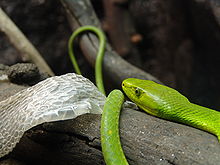
Antivenom, also known as antivenin, venom antiserum, and antivenom immunoglobulin, is a specific treatment for envenomation. It is composed of antibodies and used to treat certain venomous bites and stings. Antivenoms are recommended only if there is significant toxicity or a high risk of toxicity. The specific antivenom needed depends on the species involved. It is given by injection.

Elapidae is a family of snakes characterized by their permanently erect fangs at the front of the mouth. Most elapids are venomous, with the exception of the genus Emydocephalus. Many members of this family exhibit a threat display of rearing upwards while spreading out a neck flap. Elapids are endemic to tropical and subtropical regions around the world, with terrestrial forms in Asia, Australia, Africa, and the Americas and marine forms in the Pacific and Indian Oceans. Members of the family have a wide range of sizes, from the 18 cm (7.1 in) white-lipped snake to the 5.85 m king cobra. Most species have neurotoxic venom that is channeled by their hollow fangs, and some may contain other toxic components in various proportions. The family includes 55 genera with around 360 species and over 170 subspecies.

Mambas are fast-moving, highly venomous snakes of the genus Dendroaspis in the family Elapidae. Four extant species are recognised currently; three of those four species are essentially arboreal and green in colour, whereas the black mamba, Dendroaspis polylepis, is largely terrestrial and generally brown or grey in colour. All are native to various regions in sub-Saharan Africa and all are feared throughout their ranges, especially the black mamba. In Africa there are many legends and stories about mambas.

A snakebite is an injury caused by the bite of a snake, especially a venomous snake. A common sign of a bite from a venomous snake is the presence of two puncture wounds from the animal's fangs. Sometimes venom injection from the bite may occur. This may result in redness, swelling, and severe pain at the area, which may take up to an hour to appear. Vomiting, blurred vision, tingling of the limbs, and sweating may result. Most bites are on the hands, arms, or legs. Fear following a bite is common with symptoms of a racing heart and feeling faint. The venom may cause bleeding, kidney failure, a severe allergic reaction, tissue death around the bite, or breathing problems. Bites may result in the loss of a limb or other chronic problems or even death.
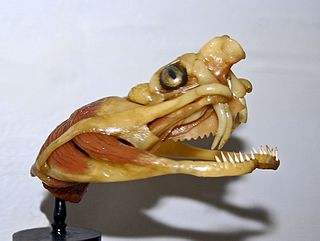
Snake venom is a highly toxic saliva containing zootoxins that facilitates in the immobilization and digestion of prey. This also provides defense against threats. Snake venom is injected by unique fangs during a bite, whereas some species are also able to spit venom.

The boomslang is a highly venomous snake in the family Colubridae. The species is native to Sub-Saharan Africa.

The inland taipan, also commonly known as the western taipan, small-scaled snake, or fierce snake, is a species of extremely venomous snake in the family Elapidae. The species is endemic to semiarid regions of central east Australia. Aboriginal Australians living in those regions named the snake dandarabilla. It was formally described by Frederick McCoy in 1879 and then by William John Macleay in 1882, but for the next 90 years, it was a mystery to the scientific community; no further specimens were found, and virtually nothing was added to the knowledge of this species until its rediscovery in 1972.

The eastern brown snake, often referred to as the common brown snake, is a species of extremely venomous snake in the family Elapidae. The species is native to eastern and central Australia and southern New Guinea. It was first described by André Marie Constant Duméril, Gabriel Bibron, and Auguste Duméril in 1854. The adult eastern brown snake has a slender build and can grow to 2 m (7 ft) in length. The colour of its surface ranges from pale brown to black, while its underside is pale cream-yellow, often with orange or grey splotches. The eastern brown snake is found in most habitats except dense forests, often in farmland and on the outskirts of urban areas, as such places are populated by its main prey, the house mouse. The species is oviparous. The International Union for Conservation of Nature classifies the snake as a least-concern species, though its status in New Guinea is unclear.
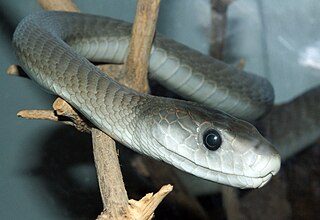
The black mamba is a species of highly venomous snake belonging to the family Elapidae. It is native to parts of sub-Saharan Africa. First formally described by Albert Günther in 1864, it is the second-longest venomous snake after the king cobra; mature specimens generally exceed 2 m and commonly grow to 3 m (9.8 ft). Specimens of 4.3 to 4.5 m have been reported. Its skin colour varies from grey to dark brown. Juvenile black mambas tend to be paler than adults and darken with age. Despite the common name, the skin of a black mamba is not black, but rather describes the inside of its mouth, which it displays when feeling threatened.
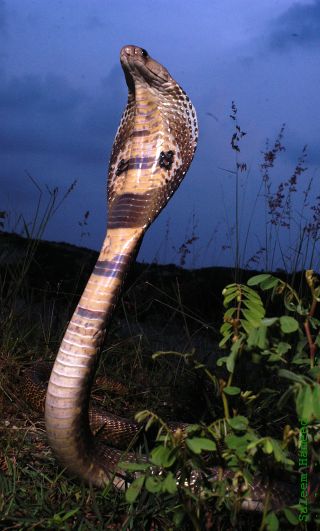
The Indian cobra, also known commonly as the spectacled cobra, Asian cobra, or binocellate cobra, is a species of cobra, a venomous snake in the family Elapidae. The species is native to the Indian subcontinent, and is a member of the "big four" species that are responsible for the most snakebite cases in India.

The Caspian cobra, also called the Central Asian cobra, ladle snake, Oxus cobra, or Russian cobra, is a species of highly venomous snake in the family Elapidae. The species is endemic to Central Asia. Described by Karl Eichwald in 1831, it was for many years considered a subspecies of the Indian cobra until genetic analysis revealed it to be a distinct species.

Atheris is a genus of vipers known as bush vipers. They are found only in tropical subsaharan Africa and many species have isolated and fragmented distributions due to their confinement to rain forests. Like all other vipers, they are venomous. In an example of convergent evolution, they show many similarities to the arboreal pit vipers of Asia and South America. Seventeen species are currently recognized.

The western green mamba is a long, thin, and highly venomous snake species of the mamba genus, Dendroaspis. This species was first described in 1844 by American herpetologist Edward Hallowell. The western green mamba is a fairly large and predominantly arboreal species, capable of navigating through trees swiftly and gracefully. It will also descend to ground level to pursue prey such as rodents and other small mammals.

Naja is a genus of venomous elapid snakes commonly known as cobras. Members of the genus Naja are the most widespread and the most widely recognized as "true" cobras. Various species occur in regions throughout Africa, Southwest Asia, South Asia, and Southeast Asia. Several other elapid species are also called "cobras", such as the king cobra and the rinkhals, but neither is a true cobra, in that they do not belong to the genus Naja, but instead each belong to monotypic genera Hemachatus and Ophiophagus.

The king brown snake is a species of highly venomous snake of the family Elapidae, native to northern, western, and Central Australia. Despite its common name, it is a member of the genus Pseudechis and only distantly related to true brown snakes. Its alternative common name is the mulga snake, although it lives in many habitats apart from mulga. First described by English zoologist John Edward Gray in 1842, it is a robust snake up to 3.3 m (11 ft) long. It is variable in appearance, with individuals from northern Australia having tan upper parts, while those from southern Australia are dark brown to blackish. Sometimes, it is seen in a reddish-green texture. The dorsal scales are two-toned, sometimes giving the snake a patterned appearance. Its underside is cream or white, often with orange splotches. The species is oviparous. The snake is considered to be a least-concern species according to the International Union for Conservation of Nature, though may have declined with the spread of the cane toad.

The coastal taipan, or common taipan, is a species of extremely venomous snake in the family Elapidae. Described by Wilhelm Peters in 1867, the species is native to the coastal regions of northern and eastern Australia and the island of New Guinea. The second-longest venomous snake in Australia, the coastal taipan averages around 2.0 m (6.6 ft) long, with the longest specimens reaching 2.9 m (9.5 ft) in length. It has light olive or reddish-brown upperparts, with paler underparts. The snake is considered to be a least-concern species according to the International Union for Conservation of Nature.

Jameson's mamba is a species of highly venomous snake native to equatorial Africa. A member of the mamba genus, Dendroaspis, it is slender with dull green upper parts and cream underparts and generally ranges from 1.5 to 2.2 m in length. Described by Scottish naturalist Thomas Traill in 1843, it has two recognised subspecies: the nominate subspecies from central and west sub-Saharan Africa and the eastern black-tailed subspecies from eastern sub-Saharan Africa, mainly western Kenya.
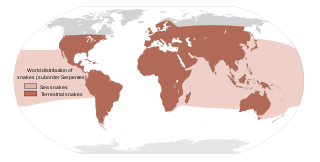
Most snakebites are caused by non-venomous snakes. Of the roughly 3,700 known species of snake found worldwide, only 15% are considered dangerous to humans. Snakes are found on every continent except Antarctica. There are two major families of venomous snakes, Elapidae and Viperidae. 325 species in 61 genera are recognized in the family Elapidae and 224 species in 22 genera are recognized in the family Viperidae, In addition, the most diverse and widely distributed snake family, the colubrids, has approximately 700 venomous species, but only five genera—boomslangs, twig snakes, keelback snakes, green snakes, and slender snakes—have caused human fatalities.

Aspidelaps lubricus, commonly known as the Cape coral snake, Cape coral cobra or coral shield cobra, is a species of venomous snake in the family Elapidae. The species is endemic to southern Africa.




